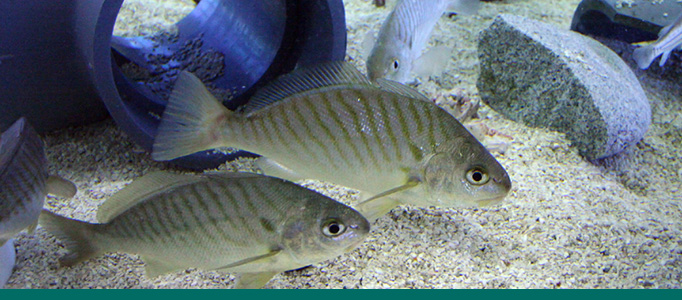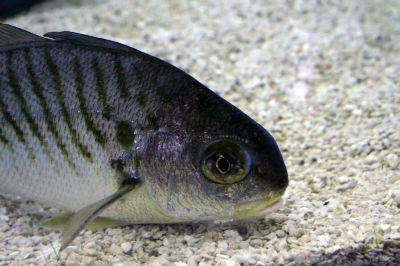Gulf Coast Gallery

When Visiting...
- Watch salt marsh fish dart through sunken driftwood.
- Explore the crags of a coastal jetty.
- Find fish between pockets of sea grass.
- See a thriving ecosystem under beams of a derelict oil rig.

For thousands of years, the Gulf of Mexico's ecosystems remained pristine and unaltered except by forces of nature.
Bays and estuaries harbored a wealth of aquatic species, and seashores and barrier islands provided undisturbed habitat for many organisms.
Salt Marshes
Daily tides govern the rhythm of life along the gulf shores.
High tides flow over mudflats, flooding the salt marshes for coastal fish. These animals live in the Gulf as adults and return to the marsh to feed and mate.
Low tides reveal a myriad of other organisms inhabiting the mudflat, including algae worms, snails, crustaceans and visiting predators.
Life on the Rock Jetty
Often projecting nearly a mile into the sea, rock jetties were constructed about 100 years ago on the seaward side of the Gulf barrier islands. The jetties stabilize inlet channels, protect beaches from constantly shifting currents and sands, and provide habitat for many rocky shore organisms.
Rigs to Reefs
The Gulf of Mexico has been perforated by thousands of drilling platforms since 1938. Yet offshore rigs may benefit Gulf species by introducing artificial habitats. Barnacles, sponges, algae and corals attach to the giant floating platforms and support legs of oil rigs. these areas attract little fishes that in turn attract larger predators.
In an effort to establish these communities, the federal "Rigs to Reefs" program sinks derelict rigs on site rather than hauling them away.
Our Actions Matter
Today, coastal habitats are burdened by human activities, including commercial fishing. You can help reduce human impact on these ecosystems by making simple choices:
- Purchase sustainable seafood. Use resources like the Seafood Watch program and Marine Stewardship Council to make ocean-friendly choices at restaurants and stores. Look for the emblem from the Global Aquaculture Alliance which certifies commercial seafood farms.
- Use less petroleum. Be mindful of the ways you use petroleum and think about how you can use less today.
- Support restoration or conservation projects. Donate to the New Mexico BioPark Society or other conservation organization to help aquatic wildlife around the world.
Gulf Coast Gallery Photos
